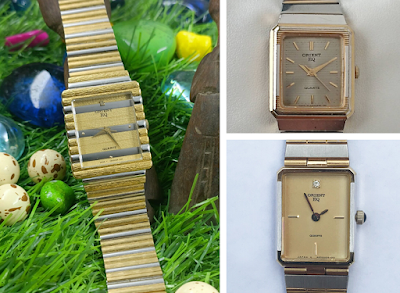Orient's started manufacturing the L-Type movement in 1961, as a
replacement to the N-Type.
It was engineered to enable lower production costs, and easier regulation and
maintenance, while offering more flexibility in adding complications and
components.
While the N-Type shaved off 0.60 mm from the thickness of the T-Type
movement that preceded it, the L-Type base (no-date) caliber was a further
0.55mm thinner. At 3.65mm it allowed Orient to produce thinner watches, and add
more layers, such as a week-day disc, or even a battery.
Calibers from the L-Type family were produced in a great variety of
price levels, with jewel counts starting at 19 and going up to 30 in
"normal" watches (and lots more in the Grand
Prix models).
The L-Type was celebrated by being introduced along with a new family of
quality watches, the Olympia. All Olympia models that followed used some
variation of the L movement or other. Yet, this caliber was also implemented in
a number of other models.
The first version of the new movement was simply, caliber L. A
hand-winding, time only movement, that powered the new Olympia watch – at that
stage still an elegant yet simple dress watch, very similar to N-Type driven
models that preceded it.
Note that 19 jewel version at that time generally did not include the
latest shock protection mechanisms, these were added to higher jewel-count
models.
In 1962, Orient presented the Olympia Calendar, and the new caliber
LC. "C" would henceforth indicate the calendar function, or date
disc, in L-Type movements.
Caliber LC would become Orient's most widely used movement of the 1960s.
It was initially used in both dressy and sportier models, like the Olympia
Calendar Swimmer, and later on in Orient's first proper dive watch,
the 1964 Olympia Calendar Diver. In also featured in various other special
models, like the triangular
case, or the lovely trapezoid at the top of this post.
A non-Olympia model was also introduced – the "Freshman",
which replaced the previous "Youth" model targeting younger clients.
It carried the simpler, 19 jewel version of the LC.
In 1963, Caliber LCY was first to include a week-day disc on top
of the date, paving the way to Orient's first day-date model – the Olympia
Orient Weekly. Alongside it Orient also introduced the Freshman Weekly – the
only Orient that had just the week-day window, but not the date.
The LCY was also presented in the form of a Swimmer model, as well as a
rectangular version.
Innovation did not cease in 1964, when the Orient
Flash went on sale. This model took advantage of the relative
thinness of the base L caliber, to create a watch containing a battery and LED lights
that enable night-time visibility and basically, just make for a very cool
looking piece of gear.
However Orient’s development of the Type-L movements did not stop at
complications and gadgetry. Alongside the aforementioned variants, Orient was
working on more important stuff – automatic winding.
Orient introduced its first automatic movement in 1961, as the “Super
Auto”. The following year, as it became clear that the L-Type was the way to
go, Orient simply borrowed the Super Auto’s efficient self-winding mechanism,
and added it on top of the new LC movement to create the caliber LCW –
with “W” obviously representing Winding.
You can read more about the LCW’s development into a high-end movement
in my blog post about the Grand
Prix series. There, you will also be able to read about the LCYW
caliber – clearly, a self-winding, day-date movement – which was reserved
exclusively for the Grand Prix.
Towards the late 1960s Orient was already developing and manufacturing a
new generation of movements. In 1970, production of the L-Type calibers ceased.
Pictures of the L-Type movements that appear on this post were taken
from the 1999 Orient Watch Catalog book.
















